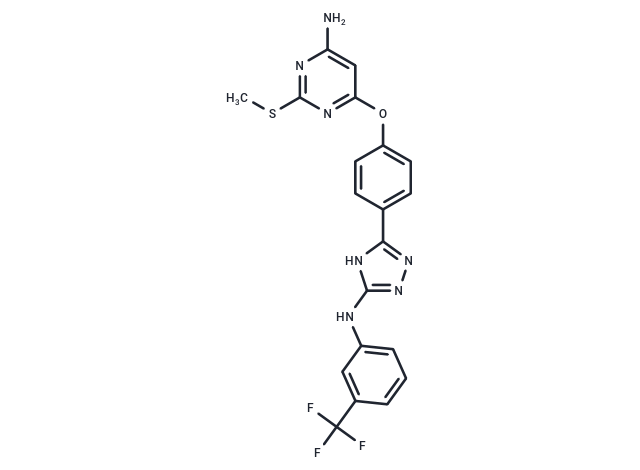Shopping Cart
- Remove All
 Your shopping cart is currently empty
Your shopping cart is currently empty

KG5 is a dual allosteric inhibitor of PDGFRβ and B-Raf with a Kd of 520 nM and 300 nM for PDGFRβ and PDGFRα. KG5 inhibits FLT3, KIT, and c-Raf with anticancer and antiangiogenic activities.

| Pack Size | Price | Availability | Quantity |
|---|---|---|---|
| 1 mg | $29 | In Stock | |
| 2 mg | $39 | In Stock | |
| 5 mg | $68 | In Stock | |
| 10 mg | $107 | In Stock | |
| 25 mg | $215 | In Stock | |
| 50 mg | $329 | In Stock | |
| 100 mg | $473 | In Stock | |
| 200 mg | $662 | In Stock | |
| 1 mL x 10 mM (in DMSO) | $82 | In Stock |
| Description | KG5 is a dual allosteric inhibitor of PDGFRβ and B-Raf with a Kd of 520 nM and 300 nM for PDGFRβ and PDGFRα. KG5 inhibits FLT3, KIT, and c-Raf with anticancer and antiangiogenic activities. |
| Targets&IC50 | PDGFRβ:520 nM (Kd), PDGFRα:300 nM (Kd), c-Kit:170 nM (Kd), FLT3:52 nM (Kd) |
| In vitro | KG5 inhibits FLT3 and KIT at 52 and 170 nM, respectively. In endothelial cells stimulated with bFGF or VEGF, KG5 (5 μM) inhibits phosphorylation of MEK and ERK. KG5 inhibits vascular smooth muscle cells (VSMCs) and endothelial cell viability with EC50 values of 0.59 μM and 0.54 μM, respectively. KG5 selectively blocks S338 phosphorylation, yet does not influence S259[1]. |
| In vivo | KG5 (1 μM) disrupts a late step in angiogenesis during zebrafish embryogenesis. In male Nu/Nu mice injected with SN12C-RFP cells, KG5 (100 mg/kg; oral) prevents tumor growth. KG5 (50 mg/kg; i.p.) completely blocks angiogenesis in mice injected with Matrigel containing bFGF with a Cmax of 3.6 μg/mL, T1/2 of 11.5 h, and an AUC0-12h of 14.7 μg•h/mL[1]. |
| Molecular Weight | 459.45 |
| Formula | C20H16F3N7OS |
| Cas No. | 877874-85-6 |
| Smiles | CSc1nc(N)cc(Oc2ccc(cc2)-c2nnc(Nc3cccc(c3)C(F)(F)F)[nH]2)n1 |
| Storage | Powder: -20°C for 3 years | In solvent: -80°C for 1 year | Shipping with blue ice. | |||||||||||||||||||||||||||||||||||
| Solubility Information | DMSO: 95 mg/mL (206.77 mM), Sonication is recommended. | |||||||||||||||||||||||||||||||||||
Solution Preparation Table | ||||||||||||||||||||||||||||||||||||
DMSO
| ||||||||||||||||||||||||||||||||||||

Copyright © 2015-2025 TargetMol Chemicals Inc. All Rights Reserved.